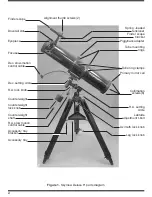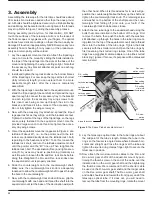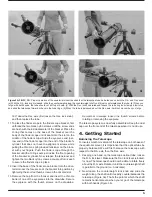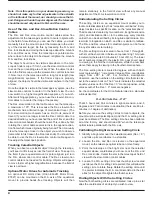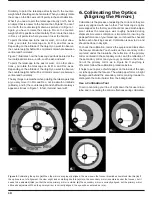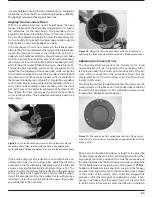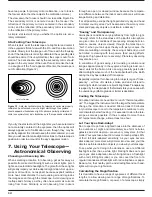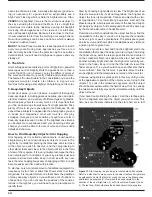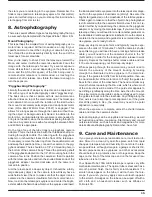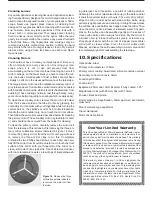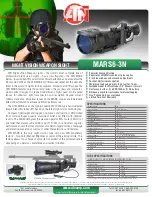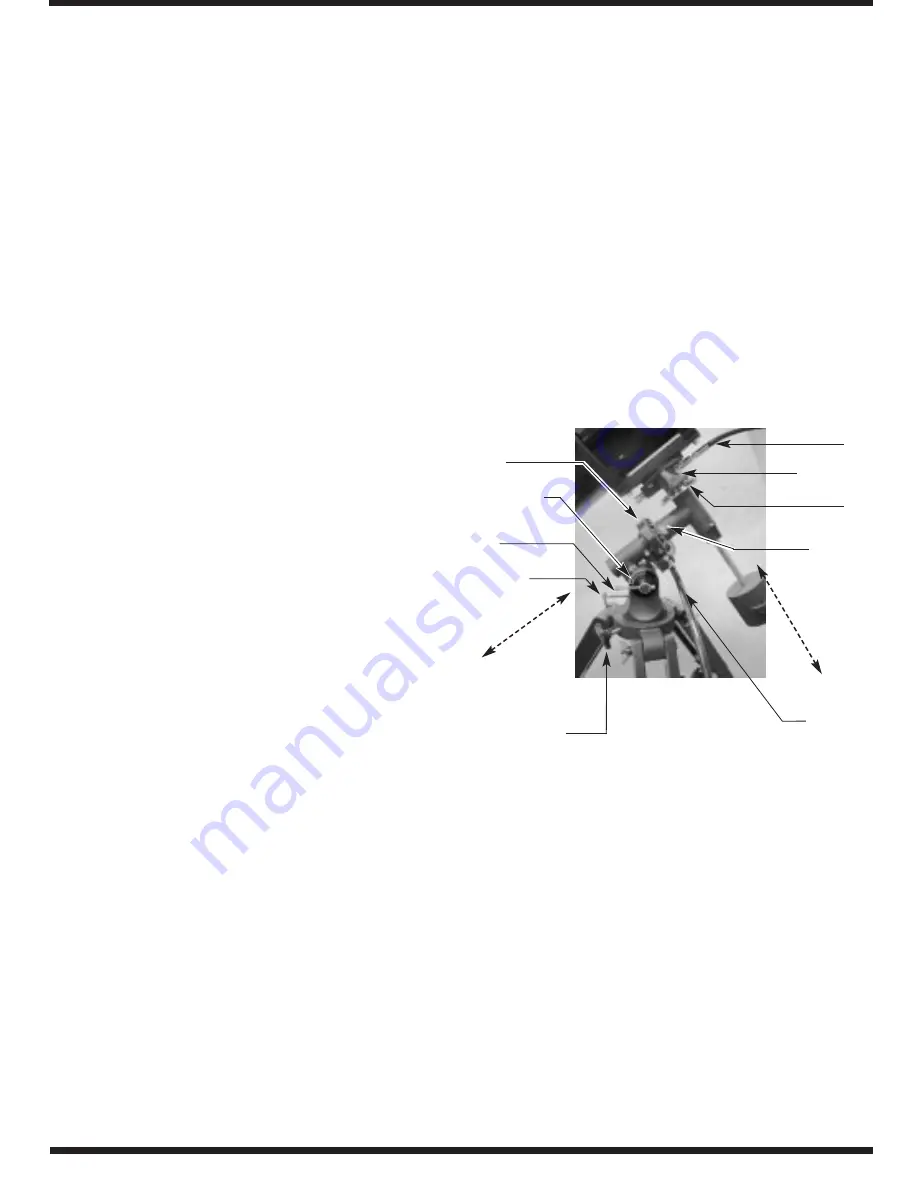
4
3. Assembly
Assembling the telescope for the first time should take about
30 minutes. No tools are needed other than the ones provid-
ed. All bolts should be tightened securely to eliminate flexing
and wobbling, but be careful not to over-tighten or the threads
may strip. Refer to Figure 1 during the assembly process.
During assembly (and anytime, for that matter), DO NOT
touch the surfaces of the telescope mirrors or the lenses of
the finder scopes or eyepieces with your fingers. The optical
surfaces have delicate coatings on them that can easily be
damaged if touched inappropriately. NEVER remove any lens
assembly from its housing for any reason, or the product war-
ranty and return policy will be voided.
1. Lay the equatorial mount on its side. Attach the tripod legs
one at a time to the mount by sliding the bolts installed in
the tops of the tripod legs into the slots at the base of the
mount and tightening the wing nuts finger-tight. Note that
the accessory tray bracket attachment point on each leg
should face inward.
2. Install and tighten the leg lock knobs on the bottom braces
of the tripod legs. For now, keep the legs at their shortest
(fully retracted) length; you can extend them to a more
desirable length later, after the scope is completely
assembled.
3. With the tripod legs now attached to the equatorial mount,
stand the tripod upright (be careful!) and spread the legs
apart enough to connect the accessory tray to the bracket
on each leg. Use the accessory tray wing screws to do
this; insert each wing screw up through the slot in the
bracket, and thread it into a corner of the accessory tray.
Do not fully tighten the wing screws yet.
4. Now, with the accessory tray attached, spread the tripod
legs apart as far as they will go, until the brackets are taut.
Tighten the bolts at the tops of the tripod legs, so the legs
are securely fastened to the equatorial mount. Use the
provided large wrench to do this. Also tighten the acces-
sory tray wing screws.
5. Orient the equatorial mount as it appears in Figure 2, at a
latitude of about 40°, i.e., so the pointer next to the lati-
tude scale (located directly above the latitude lock t-bolt)
is pointing to the hash mark at “40.” To do this, loosen the
latitude lock t-bolt, and turn the latitude adjustment t-bolt
until the pointer and the “40” line up. Then retighten the
latitude lock t-bolt. The declination (Dec.) and right ascen-
sion (R.A.) axes may need re-positioning (rotation) as
well. Be sure to loosen the RA and Dec. lock knobs before
doing this. Retighten the R.A. and Dec. lock knobs once
the equatorial mount is properly oriented.
6. Slide the counterweight onto the counterweight shaft.
Make sure the counterweight lock knob is adequately
loosened to allow the counterweight shaft to pass through
the hole in the counterweight.
7. Now, with the counterweight lock knob still loose, grip the
counterweight with one hand and thread the shaft into the
equatorial mount (at the base of the declination axis) with
the other hand. When it is threaded as far in as it will go,
position the counterweight about halfway up the shaft and
tighten the counterweight lock knob. The retaining screw
and washer on the bottom of the shaft prevent the coun-
terweight from falling off (and onto your foot!) if the
counterweight lock knob becomes loose.
8. Attach the two tube rings to the equatorial head using the
bolts that come installed in the bottom of the rings. First
remove the bolts, then push the bolts, with the washers
still attached, up through the holes in the tube ring mount-
ing plate (on the top of the equatorial mount) and rethread
them into the bottom of the tube rings. Tighten the bolts
securely with the smaller wrench. Open the tube rings by
first loosening the knurled ring clamps. One of the tube
rings has a piggyback camera adapter on top (the knurled
black ring); ignore it for now, it’s purpose will be discussed
later in detail.
9. Lay the telescope optical tube in the tube rings at about
the midpoint of the tube’s length. Rotate the tube in the
rings so the focuser is angled somewhere between hori-
zontal and straight up. Close the rings over the tube and
tighten the knurled ring clamps finger-tight to secure the
telescope in position.
10. Now attach the two slow-motion cables to the R.A. and
Dec. worm gear shafts of the equatorial mount by posi-
tioning the thumb screw on the end of the cable over the
indented slot on the worm gear shaft and then tightening
the thumb screw. We recommend that the shorter cable
be used on the R.A. worm gear shaft and the longer cable
on the Dec. worm gear shaft. The Dec. worm gear shaft
and cable should extend toward the front (open) end of the
telescope optical tube. If it does not, you will need to
remove the tube from the mounting rings, rotate the mount
RIGHT ASCENSION
AXIS
Azimuth lock knob
R.A. setting
circle lock
thumbscrew
DECLINA
TION AXIS
Figure 2. The Space Probe’s equatorial mount.
Dec. slow-
motion control
cable
Dec. lock knob
Dec. setting
circle
R.A. slow-
motion
control cable
R.A. setting
circle
Latitude scale
Latitude lock
t-bolt
Latitude adjust-
ment t-bolt


